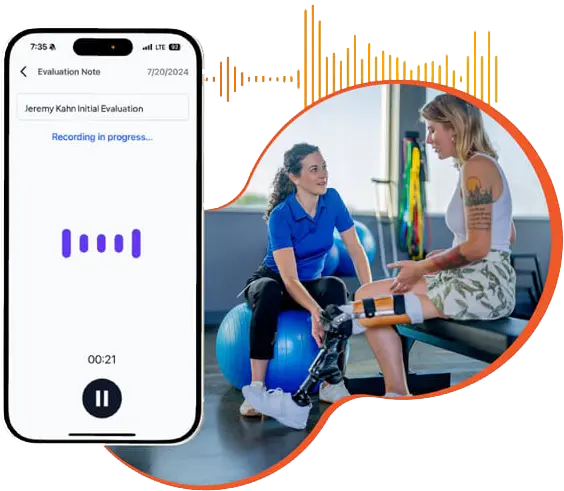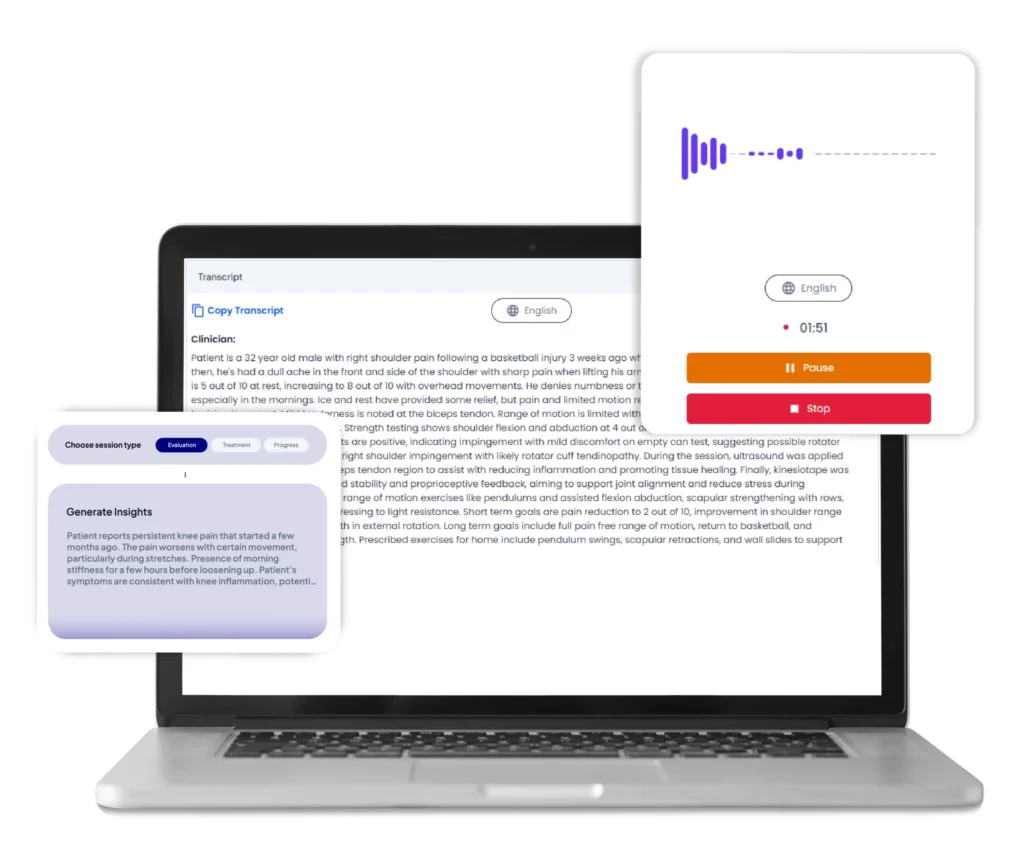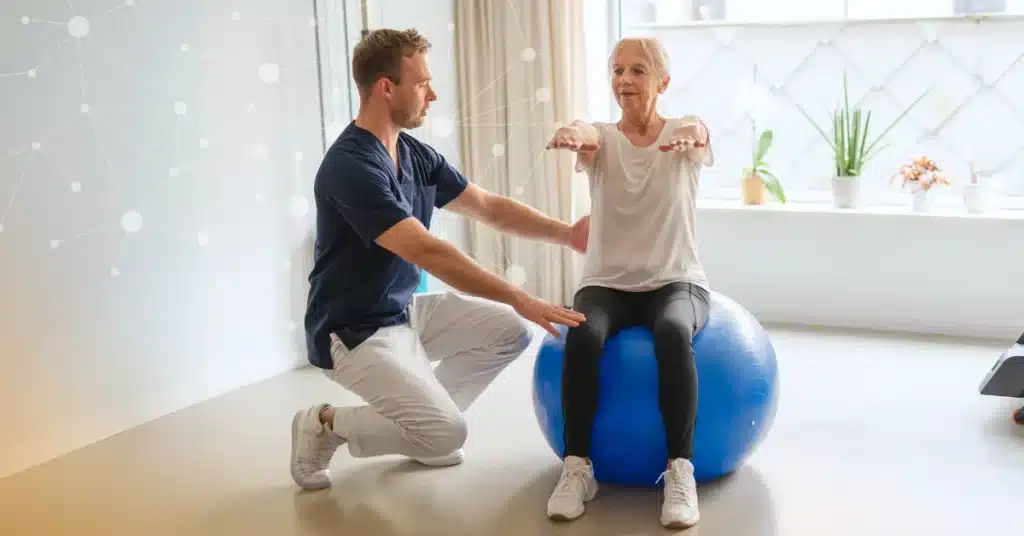You may have heard of “AI-washing.” As interest in artificial intelligence surges, many products are being labeled as “AI” simply because they automate a task. But not every tool that automates is intelligent, and conflating the two creates confusion when trying to evaluate real value.
As Director of AI at Raintree, I’m focused on advancing AI innovation to solve problems for rehabilitation and physical therapy practices. In this space, patient care is deeply personal and hands-on. At the same time, documentation burdens are high, reimbursement is complex (to say the least), and automation can only go so far in alleviating operational burdens.
One of the greatest strengths of AI is its adaptability at speed and at scale, which automation alone can’t match. This article looks at what AI in physical therapy really is—what it’s not—and where it’s already delivering meaningful impact.
Defining AI in Physical Therapy
It’s important to clarify what we actually mean by artificial intelligence in physical therapy.
Artificial intelligence includes technologies like:
- Machine learning: systems that learn from data and improve over time
- Natural language processing (NLP): allows systems to understand and generate human language
- Predictive analytics: uses historical data to anticipate outcomes
Automation, on the other hand, includes:
- Rule-based workflows
- Templates
- Simple task triggers (e.g., if X, then Y)
AI vs. Automation
The distinction between AI vs. automation, at the core, boils down to adaptability. AI learns and responds to context, whereas automation follows repeatable instructions.
Both are valuable, especially when backed by specialization and deep understanding of the end user’s goals. But understanding that difference is critical when evaluating new tech for your practice.
Common Misconceptions: What AI Is NOT
Despite its growing presence in healthcare, AI still carries a lot of baggage. In physical therapy, where relationships and hands-on care are central to the patient experience, you might be wondering “Will AI replace physical therapists?”
Let’s debunk some common myths, starting from the top:
“AI will replace physical therapists.”
AI augments therapists’ work. It can reduce documentation burden, improve insights, and enhance decision-making, but it doesn’t replace clinical judgment or human connection.“Automation is a form of AI.”
Auto-filling a template is valuable, but doesn’t make a system intelligent. True AI systems are adaptive: interpreting language, understanding clinical context, and adapting its output based on what it learns over time.“AI removes the human element of care.”
When done right, AI gives providers more time for personalized care by eliminating redundant clicks and admin overhead.
Related Content:
- Biggest Benefits of Ambient AI Scribe Tools in Rehab Therapy
- Physical Therapy and Artificial Intelligence: Interview with Drew Contreras, PT, DPT
- Raintree’s Product Evolution: Leveraging Experience to Accelerate Innovation and Adoption
- Native AI vs. Third-Party Integration: What’s the Difference and Why It Matters
Real-World Applications: How AI Is Used in Physical Therapy Today
So, what does the impact of AI look like in action?
AI for Physical Therapy Documentation
One of the clearest and most immediate use cases is AI-driven clinical documentation. At Raintree, we built ScribeIQ™, a native AI scribe that uses ambient listening technology to listen, understand, and generate high-quality notes from provider-patient conversations.
Benefits of using AI for physical therapy documentation include:
-
- Reducing documentation time by hours per week
- Enabling providers to focus on patients rather than documentation during visits
- Producing consistent, compliant notes with less manual input

Clinical Decision Support
AI is also being used to assist therapists with evidence-based insights and care planning. Known as Clinical Decision Support (CDS), this AI application leverages machine learning and predictive analytics to surface the right information at the right time to support better decision-making.
Use Cases:
- Recommend appropriate interventions based on diagnosis and patient history
- Flag potential risks or gaps in care
- Forecast patient progress and recovery timelines
Revenue Optimization
AI can play a growing role in helping PT practices get paid faster and more accurately by identifying missing charges, flagging under-coded visits, or predicting denial risk. The use of AI models trained on revenue cycle data can dramatically reduce revenue leakage and manual rework, two major barriers to financial efficiency.
Use Cases:
- Charge capture optimization
- Predictive denial management
- Real-time billing compliance checks
Computer Vision, AR, and More
On the cutting edge of rehab tech, AI is being combined with sensors, cameras, and immersive technologies to enhance patient interaction and remote assessment.
Use cases:
- Track movement and range of motion in real time
- Provide biofeedback during exercises
- Enable remote functional assessments
Patient Engagement & Experience
By using AI to personalize outreach, reinforce home programs, and even respond to patient questions, therapy organizations can help bridge the gap between visits.
Use Cases:
-
- AI chatbots for post-visit FAQs, scheduling, or triage
- Personalized exercise reminders based on adherence patterns
- Adaptive home exercise programs that respond to patient feedback or sensor data
- Voice or text-based coaching for motivation and accountability throughout the treatment plan

Marketing & Patient Acquisition
AI is also playing a role in marketing strategies, helping teams get smarter about outreach, engagement, and retention.
Use Cases:
- Predictive analytics to identify patients at risk of churn
- Dynamic content optimization on websites or email campaigns
- Conversational AI for lead capture (e.g., chatbots that answer service questions or schedule appointments)
- Patient sentiment analysis from surveys or online reviews
Native AI vs. Third-Party Integrations
Not all AI technologies are created—or integrated—equally. It’s important to understand the difference between types of integration of AI, especially if you want to stay at the cutting edge of innovation and make the most of its capabilities.
Native AI:
- Built directly into the core platform
- Can leverage full system context (like patient history, scheduling, billing rules)
Third-Party AI:
- Often add-on tools layered via APIs
- May have limited access to system data
Want to know more? Read my recent deep dive into the differences between native AI and third-party integration.
Considerations in AI Adoption
Transforming physical therapy by adopting AI in the clinical setting requires trust and alignment with care goals. Things to consider:
- Specialization. Is the tool designed for your specific needs, or generalized application?
- Workflow alignment. Where will AI speed up processes? Where will human review take place? How easy is adoption?
- Native vs. third-party. Is it built into a system or application, or integrated?
AI Designed for Rehab Therapy
When intelligence is thoughtfully applied, it goes beyond task automation to meaningfully enhance the way care is delivered. In physical therapy, that means helping you do your best work by reducing friction in documentation, decision-making, communication, and more.
That’s why, as Raintree continues to evolve and innovate, we’re “all in” on AI.
We’re delivering an AI-centric EMR experience so intuitive and naturally aligned with your workflow that it fades into the background—keeping clinicians and patients at the center of every interaction.

About the Author
Ben Catania is the Director of AI Product at Raintree, bringing extensive expertise in AI and software engineering to healthcare applications. He co-founded Yoomi Health, an AI rehabilitation therapy technology company acquired by Raintree, and previously led advertising performance initiatives at Meta. With a background in information science and economics from Cornell University, Ben has dedicated his career to bridging the gap between cutting-edge artificial intelligence capabilities and practical clinical applications that enhance patient care and streamline provider workflows.

